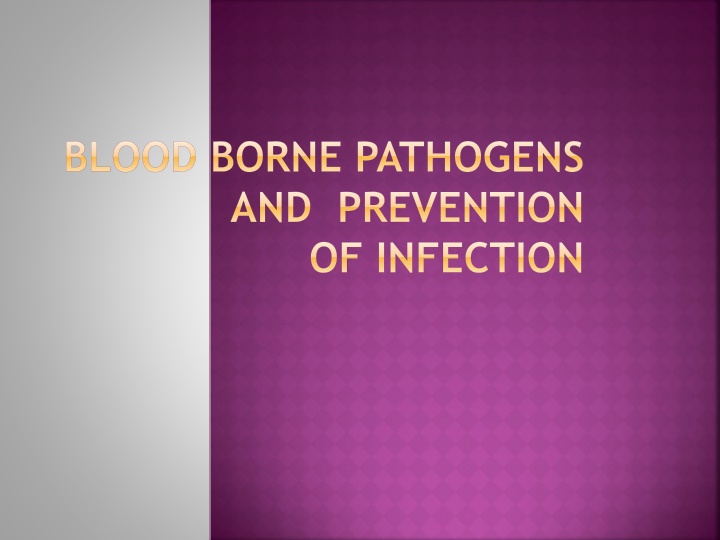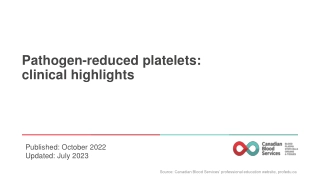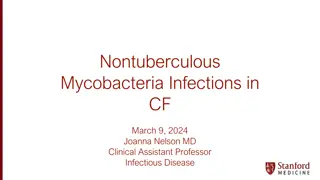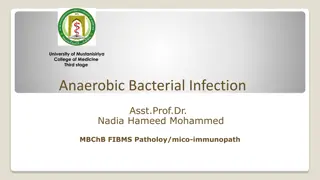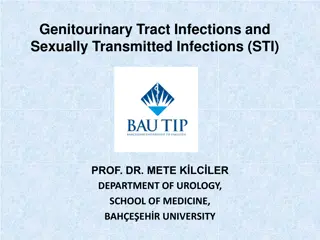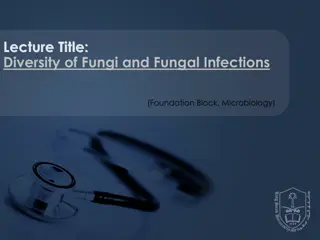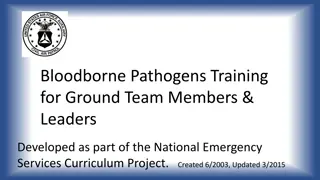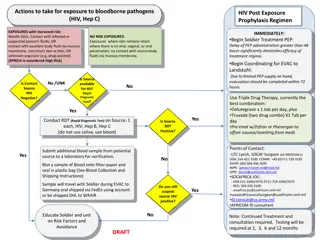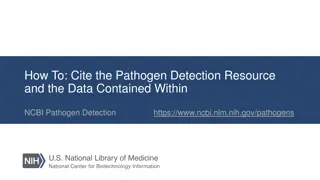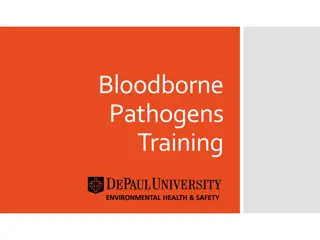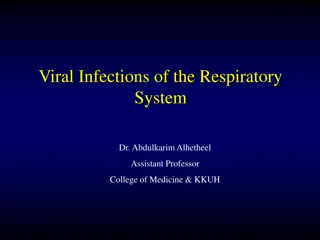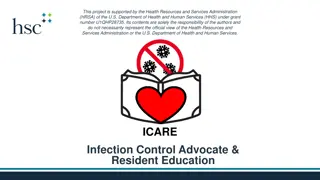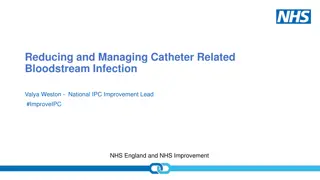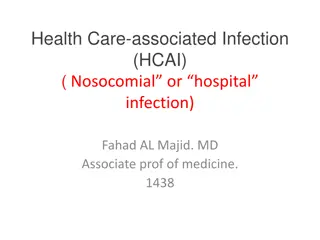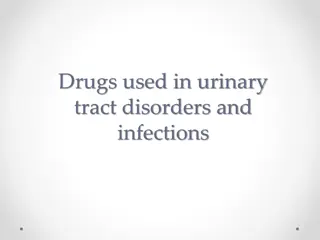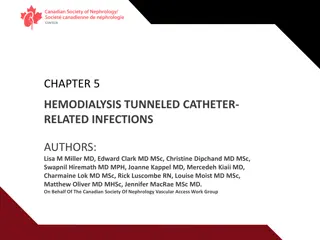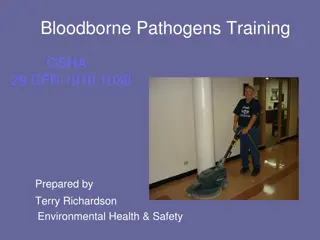Preventing Bloodborne Pathogen Infections
Learn about common bloodborne pathogens, risks to healthcare workers, modes of transmission, and prevention strategies including universal precautions and hand decontamination. Understand the importance of recognizing exposure and post-exposure care in healthcare settings.
Download Presentation

Please find below an Image/Link to download the presentation.
The content on the website is provided AS IS for your information and personal use only. It may not be sold, licensed, or shared on other websites without obtaining consent from the author.If you encounter any issues during the download, it is possible that the publisher has removed the file from their server.
You are allowed to download the files provided on this website for personal or commercial use, subject to the condition that they are used lawfully. All files are the property of their respective owners.
The content on the website is provided AS IS for your information and personal use only. It may not be sold, licensed, or shared on other websites without obtaining consent from the author.
E N D
Presentation Transcript
BLOOD BORNE PATHOGENS AND PREVENTION OF INFECTION
OBJECTIVES Identify common bloodborne pathogens. 2. Describe the risk of bloodborne pathogens to health care workers. 3. List potentially infectious substances and their modes of transmission. 4. Describe how personal protective equipment and work practice controls can be implemented. 5. Describe the health care worker s role in evaluation of workplace practices and devices. 6. Describe post-exposure care. 1. 2
BLOODBORNE PATHOGENS HIV HBV HCV Others 3
RISKS TO HEALTH CARE WORKERS HIV small HCV 900 annually HBV 9,000 annually 4
INFECTIOUS FLUIDS Blood Body fluids that contain blood Semen Vaginal secretions Fluid from around an unborn baby Spinal fluid Fluid around the heart 5
INFECTIOUS FLUIDS (CONTINUED) Fluid around the lungs Fluid around joints Tissue removed from the body 6
OTHER BODY FLUIDS Potentially Infectious Tears Saliva Sputum/nasal secretions Emesis Urine Feces Not Infectious Sweat 7
TRANSMISSION Sexual contact Sharing needles Transfusions Mom baby 8
TRANSMISSION IN THE WORKPLACE Puncture wounds Contact with non-intact skin Mucous membranes 9
PREVENTION OF INFECTION Universal Precautions OSHA Standard Precautions - CDC 10
HAND DECONTAMINATION After touching blood, body fluids, secretions, excretions, contaminated items After gloves removed Between patient contacts Waterless antiseptic agents 11
CONSIDERED AN EXPOSURE When: Blood, blood products, cerebral spinal fluid, semen, vaginal secretions or synovial fluid has had contact with NON-INTACT skin or mucous membranes. 12
CONSIDERED AN EXPOSURE When You have been stuck by a contaminated needle or sharp object 13
NOT AN EXPOSURE The following is NOT an exposure (unless visible blood noted in the following) Feces, saliva, vomitus, sputum, sweat, urine, nasal secretions, tears, blood on INTACT skin 14
PERSONAL PROTECTIVE EQUIPMENT (PPE) Provided by employer Application, removal, disposal 15
GLOVES Handling blood/body fluids Performing invasive procedure Touching non-intact skin 16
GLOVES Correct size Change if contaminated Remove inside out Utility gloves 17
MASKS, SHIELDS, EYEWEAR Used when splashing expected Replace when wet Wash hands before removing Handle by side pieces Protective resuscitation equipment 18
PROTECTIVE CLOTHING Used when splashing expected Remove if soiled Remove from inside and roll Nondisposable laundered by employer 19
WORK PRACTICE CONTROLS Sharps Lab materials Decontamination Laundry Waste 20
SAFER MEDICAL DEVICES Sharps with engineered sharp injury protectors Needleless systems 21
IF NEEDLE MUST BE USED Immediately discard in sharps containers Do not bend or break Do not recap Do not fill container past designated fill line 22
DOCUMENTATION OF NEEDLESTICK INJURIES The type and brand of device involved The department or area where the exposure occurred An explanation of how the exposure occurred 23
OTHER WORK PRACTICE CONTROLS Transport specimens in leak proof containers labeled biological hazard Place warning labels on containers with hazardous materials Do not eat, drink, smoke, apply cosmetics, or handle contact lenses where exposure likely Never use pipettes with mouth suction 24
SPILLS Put on gloves Wipe up with towel Dispose of contaminated towel Apply bleach solution 25
LINENS Wear gloves Place in impervious container if linen is to be transported Label appropriately 26
WASTE Label as biohazard 27
POST-EXPOSURE Wash area Notify supervisor Consult physician ASAP Report incident Obtain medical counseling Keep records confidential 28
C-DIFF CLostridium difficile (klos-TRID-e-uhm dif-uh- SEEL), often called C. difficile or C. diff, is a bacterium that can cause symptoms ranging from diarrhea to life-threatening inflammation of the colon. Most commonly affects older adults in hospitals or in long term care facilities and typically occurs after use of antibiotic medications. May require isolation of persons affected 29
PREVENTION Hand washing: Health care workers should practice good hand hygiene before and after treating each person in their care. In the event of a C. difficile outbreak, using soap and warm water is a better choice for hand hygiene, as alcohol-based hand sanitizers may not effectively destroy C. difficile spores. Teach visitors to practice good hand washing as well. 30
MRSA Staphylococcus aureus (MRSA) is a bacterium responsible for several difficult- to-treat infections in humans. To prevent the spread of staph or MRSA in the workplace, employers should encourage proper hand washing and sanitizing of environmental surfaces and contaminated equipment with EPA registered disinfectives. 31
PREVENTION Although alcohol-based rubs remain somewhat effective, a more effective strategy is to wash hands with running water and an anti-microbial cleanser with persistent killing action. Proper disposal of isolation gowns is also necessary MRSA can survive on surfaces and fabrics, including privacy curtains or garments worn by care providers 32
PREVENTION Hospital staff and visitors wear disposable gloves and gowns while in the room In any setting, all surfaces should be carefully disinfected with a product that contains chlorine bleach People who are hospitalized with C. difficile should have a private room or share a room with someone who has the same illness 33
POLICIES/PROCEDURES Be familiar with your facilities policies and procedures regarding issues of safety and infection control. Ask whenever you are uncertain or have a question regarding these issues. Be Safe Practice Safety in the workplace 34
SUMMARY Bloodborne pathogen risks Modes of transmission Personal protective equipment Work practice controls Evaluation of practices/devices Post-exposure care 35
